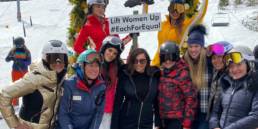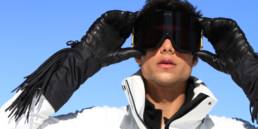Olympic Art: Behind the Net
A heroic sculpture at an Olympic venue BY HILARY STUNDA
“MY WORK COMES FROM A DESIRE TO HAVE AN EXPERIENCE that doesn’t exist, so I have to build it.” These words, from artist Janet Echelman, are not to be taken lightly: Constructing her works — which have included a 14-story sculpture called She Changes in Porto, Portugal — requires a team of engineers, millions of dollars, inven- tive software, and an ultra high-tech industrial fiber.Y Echelman’s pieces are not static works of stone or steel — her amorphous netted sculptures shift and billow in the wind 50 feet in the air. It was in Bali that the ideas that shape her work took form. “I lived in a house with a grass roof and woven bamboo walls,” she says. “I would sit and sketch, feeling protected from the rain while looking out for miles at rice terraces and volcanoes. I felt comfortable there. I was sheltered, but not cut off from the wild limitlessness of nature.” Since then, Echelman has been creating public spaces where visi- tors enter a foreign yet familiar space, creating a dialogue among themselves, others, and nature itself. Her latest project, the Water Sky Garden at Vancouver’s Richmond Olympic Oval, is yet another realization of her artistic vision, thiis time with a decidedly global approach
For inspiration Echelman researched the region, noting the strong Asian influence on local history. She was especially drawn to the city’s Nitobe Memorial Garden and Dr. Sun Yat-Sen Chinese Garden. “I made sketches of how I felt moving through those spaces — along curving bridges with views framed in such a way that the journey was an end in itself. Then we made a three-dimensional digital model of the Olympic Oval site and projected my sketches onto them, to envision a different kind of experience moving through the space.” To reach the Oval, visitors will step onto a vibrantly red undulat- ing boardwalk — the color and curvature reference Chinese dragon dances performed locally — and meander through a native wetland garden. Along the way there are seats, bridges, and rocks strategically placed for spontaneous contemplation. And suspended 50 feet above from painted steel rings are two giant red “sky lanterns.” The netted form pays homage to Vancouver’s native Musqueam Band, who still teach their children to fish on the Fraser River, as well as area craftsmen who make industrial fishing nets. The net- ting embraces the space in organic, embryonic forms that make the choreography of the wind visible to the human eye, bringing viewers in touch with the elements. It’s an all-encompassing envi- ronment, with art in the sky and in the pond below, where patterns and reflections move across the water like apparitions.The installation has an environmental benefit too. Runoff water from the Oval’s roof is channeled into the water garden and remedi- ated with specific plants that help purify it before it flows into a pump stationandthentothe Fraser River. Even thefountainscreatebubbles that aerate and clean the water, a fitting metaphor for this latest incar- nation of Echelman’s art — water and air flowing and cycling through each other, using the wonder of nature to transform a public space.




